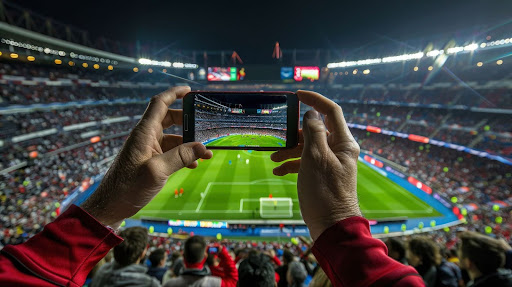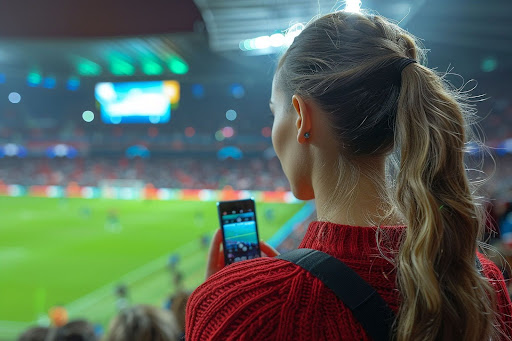9 Tips for Capturing Better Sports Photos with Your Phone
In the world of sports photography, professional cameras often steal the spotlight, but with today’s advances in smartphone technology, capturing high-quality sports photos has become much more accessible. You don't need an expensive DSLR to snap incredible action shots! Whether you're photographing a school soccer match or a professional event, your phone can do the job. The secret lies in mastering a few simple techniques.
Let’s dive into some expert tips on how to take sports photos using just your phone, and make your images stand out.
 1. Know Your Camera’s Capabilities
1. Know Your Camera’s Capabilities
Before heading to the field, familiarize yourself with your phone’s camera features. Does it have burst mode? What about fast autofocus? These tools are essential for sports photography, where the action unfolds in a split second. Burst mode, for example, allows you to take multiple photos in rapid succession—perfect for capturing that winning goal or slam dunk. High-end smartphones often feature multiple lenses, so figure out which lens performs best for motion shots. Wide-angle lenses are great for capturing the entire field, while telephoto lenses zoom in on individual athletes.
This also includes understanding the amount of memory available for taking photos. If you don’t prepare enough space, you may see a “memory full” message right at the most important moment of the match. Are you looking for a solution, how to clean up iPhone storage? The fastest way is to use the best cleaning app for the iPhone. If you have the
CleanUp app, you can get rid of unnecessary duplicates and compress videos in a couple of taps. This is the fastest way to cleanup pictures and free up memory on your device.
2. Use the Right Settings
Settings matter. If you're aiming to freeze motion, ensure you’re using a fast shutter speed. Most smartphones don’t allow direct control over shutter speed, but you can use apps like Camera+ or Lightroom that enable manual adjustments. A shutter speed of 1/1000th of a second or faster is ideal for most sports.
ISO and exposure are equally important. High ISO settings help in low light situations, but be careful: too high, and you might introduce noise to your photos. During daytime games, keep your ISO low to ensure a clean image. It’s also wise to use auto-exposure lock to maintain consistent lighting throughout the series of shots. Did you know that
over 40% of sports photographers adjust ISO settings regularly depending on light conditions?
3. Position Yourself Strategically
To capture the best moments, position yourself wisely. Where you stand can completely transform the feel of your photos. When covering a football match, for example, standing near the goalpost can give you better chances of capturing those critical scoring moments. If you’re too far, you might miss key expressions or details that make your photos compelling.
Also, think about angles. Shoot low to emphasize the power of an athlete’s movements or try a wide-angle shot to show the scale of the competition. Keep moving! Don’t stick to one spot. Be agile, especially when capturing fast-paced sports like basketball or tennis.
4. Focus on the Athlete’s Face and Expression
Sports photography is not just about documenting the game. It’s about telling a story. And what better way to do that than by focusing on the athlete's expressions? Victory, defeat, determination—these emotions define the essence of sports and make for engaging photos. Use your phone’s tap-to-focus feature to zero in on faces instead of the action itself. This creates more emotionally driven shots, connecting viewers to the intensity of the moment.
5. Maximize the Lighting Available
Natural light is your best friend. Always try to shoot in well-lit environments, and avoid using the flash unless absolutely necessary. Flash tends to flatten the subject and creates harsh shadows, which may ruin the shot. Most outdoor sports offer plenty of light during the day, but when shooting indoors, such as in gyms or arenas, you’ll need to adjust your settings accordingly. If possible, use an external light source to complement the available light and reduce the chances of blurry images.
According to a survey over 60% of photographers believe
natural lighting significantly improves the quality of sports images. So, make sure you position yourself with the sun or primary light source at your back for the best results.
 6. Leverage Burst Mode for Action Shots
6. Leverage Burst Mode for Action Shots
Sports photography is all about capturing movement. Relying on single-shot mode can be risky when athletes are running, jumping, or changing direction quickly. This is where burst mode comes in handy. Burst mode takes a series of photos rapidly, and you can later choose the best one. Whether it’s a runner breaking the finish line or a basketball player making a crucial jump shot, burst mode allows you to freeze that perfect moment.
7. Keep Your Phone Steady
One of the biggest challenges of phone photography is keeping your hands steady. Motion blur can be the enemy of sports photography. A tripod or a monopod can help stabilize your phone, especially when zooming in on the action. If you don’t have one, try holding your phone with two hands or leaning against a surface to reduce shaking.
8. Edit with Precision
Once you’ve captured your shots, don't forget the power of post-production. Editing apps like Snapseed, VSCO, or Lightroom Mobile can elevate your sports photos to professional levels. You can adjust the contrast, sharpen the details, or even crop to enhance focus. However, don’t go overboard with filters; the goal is to keep the image natural while making key elements like the athlete or action pop.
9. Practice Makes Perfect
The key to taking better sports photos with your phone is practice. Don’t wait for the big game; practice shooting during local games, practices, or even casual matches with friends. This allows you to become more comfortable with your camera settings, angles, and timing. And remember, every sport is different. Capturing a tennis serve requires a different approach than photographing a marathon. Keep experimenting until you find your style.
Conclusion
Smartphone sports photography is all about quick reactions, a deep understanding of your device, and a passion for capturing the raw energy of the game. With the right settings, strategic positioning, and some post-editing tweaks, you’ll be able to create stunning sports images that rival those taken by professional photographers. So grab your phone, hit the field, and start shooting!

